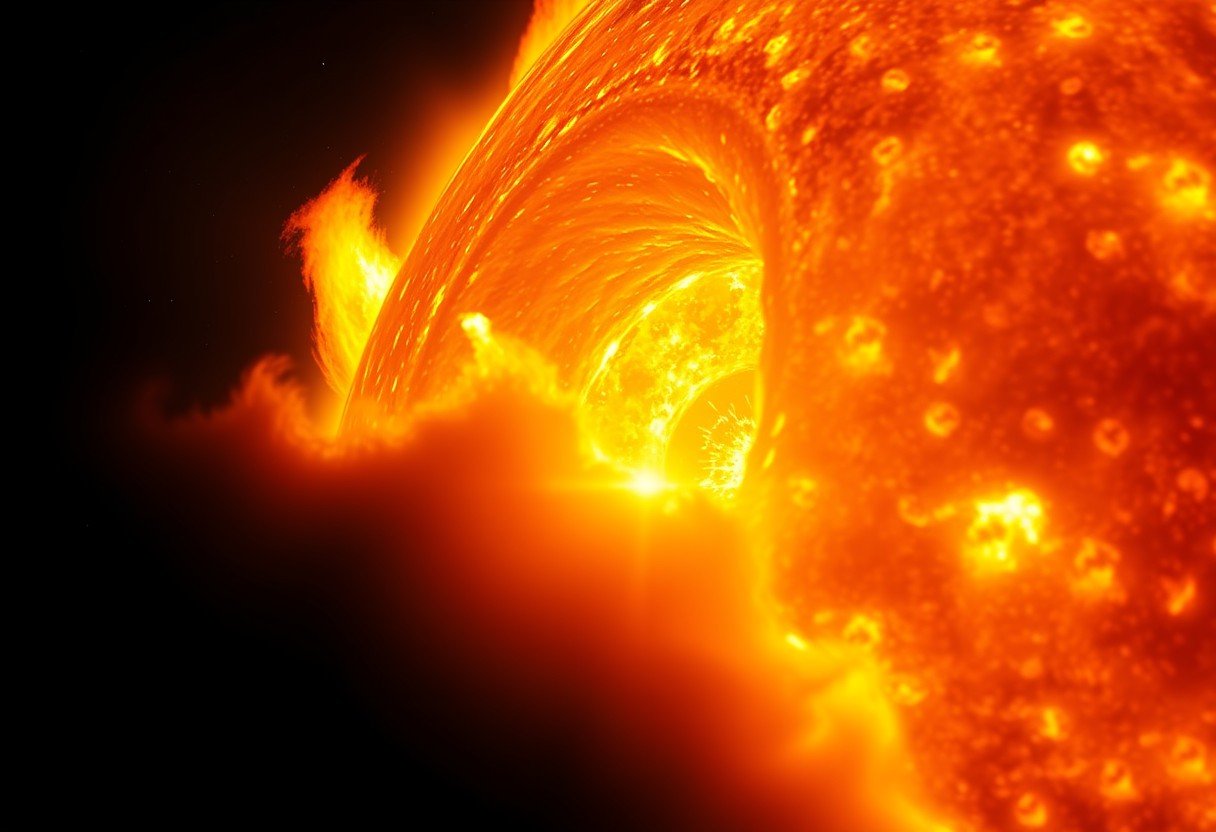What happens if the Sun’s core suddenly shrinks, when could it matter, where does it occur, why should we care, how would it play out, and who would feel it first This evergreen guide explains a rare but useful thought experiment that helps us understand how our star works and how Earth stays safe.
How the Sun stays in balance
The Sun is a huge sphere of hot plasma made mostly of hydrogen and helium. At its center sits the core, where temperatures reach about 15 million degrees Celsius and pressure is extreme. In this furnace, hydrogen nuclei fuse into helium and release energy that powers sunlight.
The Sun holds itself together by a balance of forces. Gravity pulls inward while pressure from hot gas and radiation pushes outward. This delicate match is called hydrostatic equilibrium. When one side changes, the other side responds until balance returns. This self correction is why stars live for billions of years.
- Core radius is about 20 to 25 percent of the Sun’s radius
- Core density is roughly 150 grams per cubic centimeter
- Solar luminosity is about 3.83 x 10^26 watts
Energy born in the core does not reach the surface at once. Photons scatter many times and drift outward very slowly. The journey takes on average tens of thousands of years. That lag means fast changes deep inside do not show up at the surface right away. Neutrinos are different. They fly out almost at light speed, so they reveal core changes within minutes.
Fusion in our Sun mostly follows the proton proton chain. Its energy rate is very sensitive to temperature. A small rise in core temperature increases fusion a lot. This sensitivity is key to what would happen if the core suddenly became smaller and denser.
What a sudden core shrink would do inside the Sun
Imagine the core contracts a little without changing the Sun’s total mass. The dense core would heat up as gravity does work on it. Hotter core means faster fusion, at least at first. This is the classic thermostat of stars. More fusion raises internal pressure, which pushes back and slows the collapse.
The first response is a spike in core temperature, pressure, and fusion rate. As the core tightens, gas and radiation push harder. If the change is small, the Sun finds a new balance. If the change is large, the inner layers may ring like a bell with sound waves that slowly die out.
- Core contracts a bit, temperature rises, fusion speeds up
- Pressure increases and resists further collapse
- Star settles toward a new steady state over thermal timescales
Inside the Sun, only layers above the core feel a stronger inward pull from the condensed core. These inner layers can shift slightly, but the outer half of the Sun remains close to hydrostatic balance. The star does not tear itself apart. It adjusts in a smooth way because pressure responds quickly to changes.
How big could the fusion boost be The proton proton chain scales roughly like temperature to the fourth power in this range. A 5 percent rise in core temperature could raise local energy generation by about 20 percent. That is a big change deep inside, but it does not translate instantly to the surface brightness.
Changes in light output and what Earth would feel
The Sun’s surface brightness cannot jump fast because the outer layers store a lot of heat. This thermal inertia smooths changes. Neutrino flux would jump within minutes after a core contraction. Surface light would adjust slowly over thousands to millions of years, not days.
Short term, total solar irradiance at Earth varies only about 0.1 percent across the 11 year solar cycle. That small swing already shows how stable the Sun is. Even if core fusion rose more than that, the extra heat would be trapped inside for a long time. So there would be no sudden worldwide climate shock.
| Signal | When it changes | What it tells us | Effect on Earth |
|---|---|---|---|
| Solar neutrinos | Minutes to hours | Immediate change in core fusion rate | No direct climate effect |
| Helioseismic waves | Hours to days | Shifts in internal structure and sound speed | No climate effect |
| Surface brightness | Thousands to millions of years | Thermal response of the envelope | Slow climate drift over long timescales |
Climate responds to long term changes in sunlight. A 1 percent change in the energy reaching the top of the atmosphere can nudge global temperature by about half a degree Celsius or more over time. But the Sun is very steady. Records since 1978 show no large trend in total solar irradiance beyond the normal cycle.
Gravity and planetary orbits
Planetary orbits depend on the Sun’s total mass, not where that mass sits, as long as the Sun stays nearly spherical. A small core contraction does not change the Sun’s mass. It only changes how mass is packed inside. Outside the Sun, gravity looks the same. That means no sudden shifts in Earth’s orbit.
Over very long times, the Sun slowly loses mass through the solar wind and light. The rate is tiny, about 0.01 percent in 100 million years. This slow mass loss makes all orbits expand slightly. Earth’s orbit increases by a few thousand kilometers per million years, which is small compared to its average distance of 150 million kilometers.
If the core shrink came with real mass loss or a major change in shape, the story would be different. But physics does not support that in this scenario. The Sun remains close to spherical and the total mass stays about the same. So the solar system remains dynamically stable.
Timescales and long term evolution
Stars have a thermal or Kelvin Helmholtz timescale. For the Sun it is about 30 million years. This is how long the Sun could shine using stored heat if fusion stopped. It also sets how fast the Sun’s outer layers can adjust their temperature after core changes. This clock keeps surface changes slow.
On billion year timescales, the Sun naturally brightens as helium ash builds up and the core contracts slowly on its own. Luminosity rises about 10 percent every billion years. This is normal solar aging. A sudden small contraction would act like a brief step along this path, then the star would settle again.
The Sun’s energy source remains the proton proton chain until core hydrogen runs low. In roughly 5 billion years, the core will contract more, heat up further, and ignite shell burning. The outer layers will expand and the Sun will become a red giant. This is the real path to major change, not a small short term contraction.
Thermal diffusion inside the Sun is what prevents fast surface swings. Energy takes tens of thousands of years to leak out. So even a 20 percent boost in core energy production might lead to only a very slow rise in surface output, spread over many millennia.
The key insight is simple. The Sun is a self regulating engine. Small internal jolts trigger restoring forces that bring the system back to balance. That is why life on Earth has enjoyed stable sunlight for billions of years.
How scientists would test this idea and what we see today
If the core shrank and fusion sped up, detectors on Earth would notice a change in solar neutrinos first. Neutrino observatories already track the Sun’s output with high precision. Any sudden rise would be visible in hours or days. So far, observations match stable models within small errors.
Helioseismology studies sound waves that bounce inside the Sun. Instruments like SOHO, SDO, and GONG measure tiny shifts in the five minute oscillations. A core contraction would alter sound speed and mode frequencies. Scientists would see a pattern of changes that maps the new internal structure.
- Neutrinos show real time fusion rate in the core
- Helioseismology reveals density and temperature profiles
Space missions and ground stations also track total solar irradiance and magnetic activity. The measured solar brightness varies only a tenth of a percent with the cycle. Sunspots, faculae, and flares affect the surface and corona, but not the deep core. Data from the last four decades show no signs of a core shock.
Models that include hydrostatic equilibrium, energy transport, and nuclear physics can simulate a forced core contraction. They predict a quick neutrino rise, small shifts in mode frequencies, and a very slow brightness drift. Observations agree with the picture of a Sun that is stable and well behaved.
Common myths and what would not happen
It is easy to imagine a chain reaction that makes the Sun explode. That is not how the Sun works. Our star does not have enough mass to trigger a supernova. A small core contraction would not unleash runaway fusion. The thermostat effect stops it.
Another myth is instant climate chaos. The surface and the vast convective envelope act like a giant heat battery. They release energy slowly. Earth would not see a sharp jump in sunlight. Any change would be gradual and spread across a very long time.
Some worry about planetary orbits tumbling if the core shifts. As long as the Sun stays nearly spherical and its mass stays the same, the gravity felt by planets does not change. The math comes from Newton’s shell theorem. It has been tested for centuries and holds true here.
Bottom line. A small, sudden core shrink would cause a brief rise in fusion deep inside, a fast blip in neutrinos, tiny internal ringing, and a very slow drift in brightness. Life on Earth would not face a sudden solar shock from this event.
FAQ
Would a sudden shrink in the Sun’s core make the Sun brighter right away
Not at the surface. Fusion in the core would rise fast, but the outer layers release energy slowly. Neutrinos would spike within minutes. The visible brightness would change only gradually over thousands or more years due to thermal inertia.
Could Earth’s orbit change if the core becomes denser
No, not if the Sun’s total mass stays the same and the Sun remains nearly spherical. Outside the Sun, gravity depends on total mass. Core density does not matter to planetary orbits in that case.
How big is the core compared to the whole Sun
The core is about one quarter of the Sun’s radius and contains roughly one third of its mass. Temperatures exceed 15 million degrees Celsius and pressure is hundreds of billions of times Earth’s atmospheric pressure.
What is the fastest sign that the core changed
Solar neutrinos. They are made in fusion reactions and escape the Sun almost at once. Detectors on Earth would see a change within hours, long before any surface change is visible.
Could a core shrink trigger solar flares or a supernova
Flares come from magnetic activity in the outer atmosphere, not from the core. A core tweak does not trigger a supernova because the Sun is too light for that fate. A small contraction would not cause an extreme flare storm.
Would Earth’s climate cool or warm in the long run
If core fusion stays slightly higher, the Sun would slowly brighten. That would push toward warming over many thousands of years. The change would be far smaller and far slower than human driven climate change over the next few centuries.









Leave a Comment